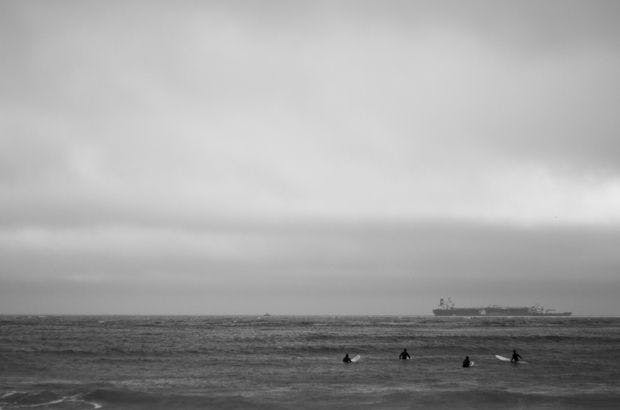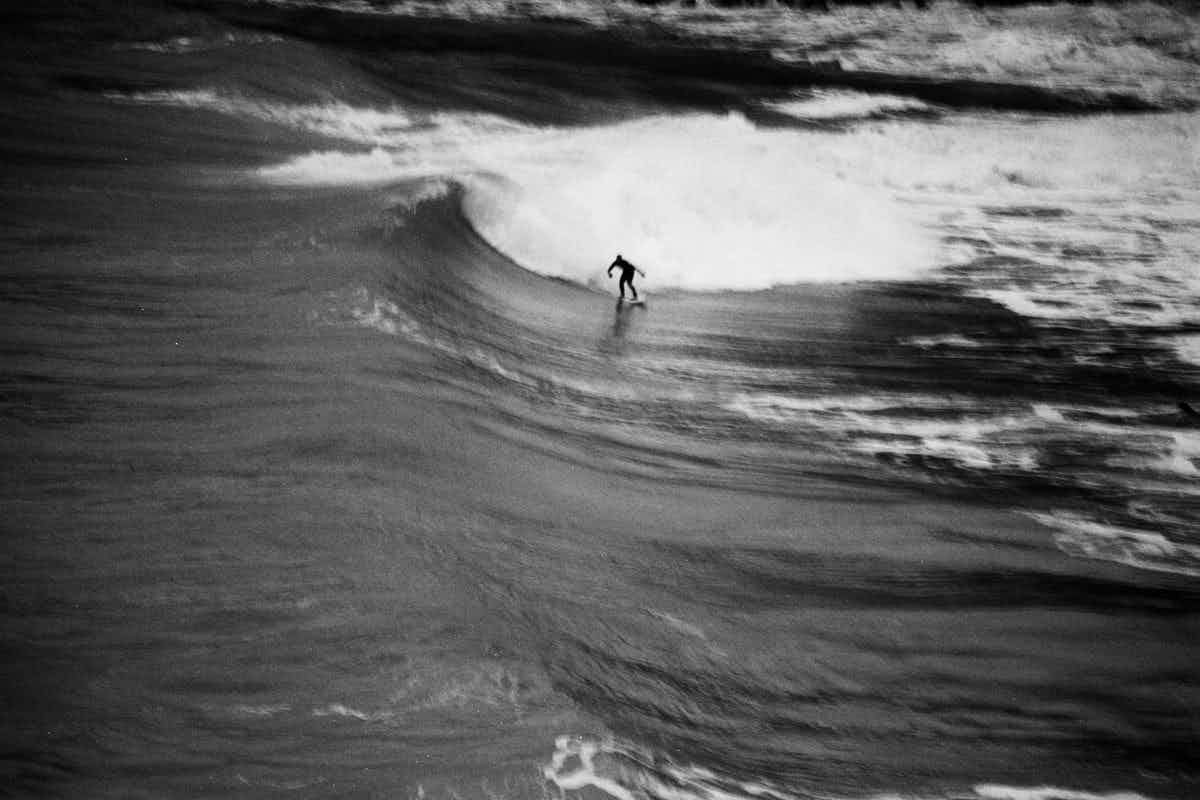Image: Surfer Mick Jardine bottom turning in the moonlight, during a mid-winter early morning surf in Northern Europe.
It’s the middle of winter and I am bloody freezing. My hands are doing that claw thing where they get so cold that you can’t close your fingers together and that, along with a thick, heavy wetsuit, makes paddling anywhere more mission than movement. Crossing my arms and hugging my numb paws into my armpits just hurts, so I decide that holding them under the water and keeping them out of the wind is a better idea. The light is flat and grey and there is a band of rain being carried towards me on the onshore wind; I watch the opaque curtain envelop the headland a mile away and wonder what’s keeping me out here scratching around for waist-high onshore mush? A small part of me is secretly hoping that the angry bull seal who took up residence here last winter, and who’s developed a reputation for bullying surfers back to the beach, will turn up so that I have an excuse for catching a wave in.

I’m not living some sort of cold-water surf adventure right now; there are no scenic mountains when I look inland, the beach isn’t covered in snow and there are no killer whales cruising the line-up or bears stalking the shoreline. Just our territorial seal whose intentions none of us are ever absolutely certain of when he surfaces within kicking distance of one of us. But it’s plenty cold enough and to be honest once your extremities are numb I’d argue that the difference between the water temperature being 7 degrees and 5 degrees Celcius isn’t noticeable, particularly once you factor in the wind-chill. Cold is cold, it’s as simple as that. And this is the reality for an awful lot of surfers. Life isn’t one long boardshort advert.
So what keeps so many of us in the sea for so long when often it’s uncomfortable and not the most productive use of our time?
What is the “S” factor?
There’s a strong case for the argument that those surfers who you see bobbing around the line-up on a distinctly average day in mid-winter, or obsessively hopping from look-out spot to look-out spot searching for waves just because it’s the weekend, have another thing driving them. It’s that little something that separates them from the multitude of humans who have caught a wave at some point in their life but not succumbed to the obsession and let it take control of their day-to-day. It stands to reason; if every person who learnt to stand up on a surfboard had this then the line-up would be just as crammed on a dreary onshore morning in mid-winter as it is on the sunniest day of the summer holidays. But it’s not. It’s just the select few who have mastered the ability to turn the key in the car door when their hands are too cold to function properly or who often don’t get the feeling back in their toes until the end of the evening news, long after dark has fallen.
Take yourself as an example: Have you ever made a decision where the dominant influence in your choice was surfing? A big decision perhaps, like where you live or what you do to earn a living? Could you blame surfing for a less than desirable financial situation or the break-up of a relationship? You see?
The simple answer would be to blame this sort of behavior on some kind of addictive behavior trait. But that’s too obvious to ring true. If that was the answer then regular surfers would display those sorts of behaviors in other areas of their lives, but the vast majority of us don’t. Some surfers are happy to forego daily surfs unless the waves are actually good, preferring to survive off memories of better waves and just to scratch the itch when absolutely necessary, on a weekly or fortnightly basis when a new swell shows up on the charts. Others just have to get in as soon as there’s a lump of water to paddle into; a bad surf is better than no surf sort of attitude, regardless of how frustrating it is.
Call it stoke, call it sensation seeking, or scientifically attribute it to varied levels of neurotransmitters such as dopamine, norepinephrine and serotonin in surfers. Both dopamine and serotonin help our brains to regulate mood and emotion, are responsible for levels of arousal, and determine how we perceive reward. It has been put forward that many surfers display behaviors indicative of heightened levels of dopamine, but whatever it’s down to, regular surfers can’t seem to get enough of it in one way or another which is why we keep going back. The best things are often the most difficult to explain and we all have our own reasons, so don’t worry that when somebody asks why you insist on paddling out whilst everybody else retreats indoors to the comfort of their favorite chair, you struggle to come up with an answer that comes anywhere close to explaining why. You don’t have to.
